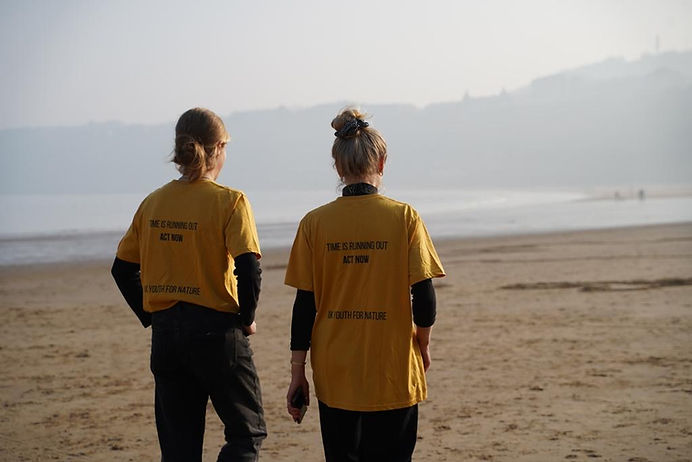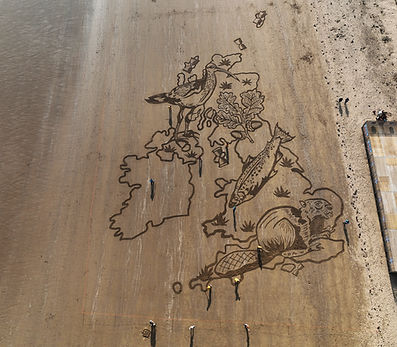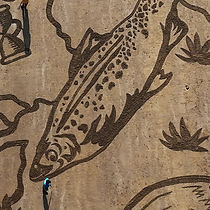
Nature Loss: Lines in the Sand
March 2022
On the 23rd of March 2022 UK Youth for Nature partnered with Sand in Your Eye to create a 50 meter drawing on Scarborough beach representing biodiversity in Britain. We’ve chosen four biologically significant species that have been drawn together to represent the amazing species we have here in Britain. Sadly, we’ve become one of the most nature depleted countries in the world. Our small, highly managed islands have pushed wildlife to the fringes of human development. UK Youth for Nature is fighting to turn this around before it is too late.
“FOR YEARS WE’VE SEEN NATURE REMAIN ONE OF GOVERNMENTS’ LOWEST PRIORITIES IN THE UK. WHEN TODAY’S YOUNG PEOPLE ARE OLDER, SOME OF THE MOST ICONIC SPECIES OF THE BRITISH COUNTRYSIDE COULD ALREADY HAVE BEEN LOST FOREVER. OUR DRAWING IS A LOUD AND CLEAR MESSAGE TO OUR GOVERNMENTS: THIS YEAR THE UN BIODIVERSITY CONFERENCE IS A ONCE IN A DECADE CHANCE TO SET NEW GLOBAL NATURE GOALS. TAKE THAT CHANCE, THEN ACT TO MEET THOSE GOALS.
TALIA GOLDMAN – CO-DIRECTOR, UK YOUTH FOR NATURE

THE LOSS OF NATURE IN THE UK IS PART OF MUCH WIDER, GLOBAL DECLINES.
While the sand drawing was being created on the beach in Scarborough, in Switzerland young people were gathering alongside government negotiators, meeting to discuss a 2030 global deal on nature.
This new deal will set global goals to stop the loss of biodiversity and habitats. The 2020 goals that the world set were all missed. Young people have no doubt that world leaders will make impressive promises in Geneva, and later this year at the conference in China where the deal will be concluded.
Nature underpins global food production, can protect people from the impacts of climate change, stores huge amounts of carbon, and brings joy and income to millions of people worldwide. But the key is to: make the restoration of nature a priority for public finance; set rules that will shift trillions of global private finance to be nature friendly; implement actions on the ground to restore nature; enforce these goals; report on progress.
The UK is one of the world’s richest countries financially, but we’re one of the poorest for nature. We should halt its loss by 2025. Globally, the destruction of nature must be stopped, and reversed by 2030.


POLITICAL ASKS – WHAT WERE WE TRYING TO ACHIEVE?
1. We know that stopping nature loss by 2025 is ambitious, but we also know that nature cannot wait. We depend on nature for our survival: for our wellbeing, food, air, water, and as vital carbon stores. We have no choice but to halt its loss and reverse it. That is why UK Youth for Nature is calling on the governments of the UK to set an early target of 2025 to halt all nature loss in the UK, and reversed by 2030.
2. Greater ambition in our 30 by 30 commitments. The Government claims that nature and protected areas already comprise 26% of land in England. However, the reality is that only 5% of this land is in a good enough condition. The Government must act urgently to make sure 30% is reality not rhetoric.
3. The UK missed most of its 2011-2020 UN nature goals. The ambition of the 2030 goals it will sign up to this year is irrelevant if these goals are not met. As one of the richest countries in the world, the UK has the means to stop the loss of nature completely by 2025 and put it into reverse gear by 2030.
4. We need a clear and effective national plan for protecting and restoring nature, that also considers other vital land use such as growing food. This must protect and restore nature across more than 30% of all land.
WHY THESE SPECIES?

The Eurasian curlew is Britain’s largest wading bird and a bioindicator species, which means they represent the overall health of the landscapes they are found in. Their yearly travels take them over coastal mudflats, bogs, lowland pastures and upland farmland. It is this range of habitat use that make them such an important species as they represent the interconnectedness of British landscapes.
Sadly, over the last 50 years the number of curlews have halved and they are at real risk of extinction as a breeding bird in parts of Wales, Ireland and lowland England. Their role as a bioindicator species means their decline shows that all is not well across Britain.Fortunately, conservation measures that help curlews also help a number of other species including lapwing, skylark and snipe. The work of charities like Curlew Action are therefore vital, not just to save our curlews, but for many other species as well.

Beavers are both a keystone species and an ecosystem engineer – meaning they are critical for helping to hold ecosystems together and for enhancing them. By digging canals, building dams, and so much more, they reshape rivers and wetlands for the benefit of so many wildlife species and humans alike. These benefits include: helping to filter out pollution, capturing carbon, and reducing flooding.After being hunted to extinction, beavers are now being reintroduced all over the UK. It still remains a highly politicised question with a lot of opposition, but the benefits are too wide ranging to ignore.

Oaks are among the most loved trees in Britain and provide enormous value for our flora and fauna. Did you know that no other species of tree in the UK supports a greater diversity of life than an ancient oak? A staggering 2,300 species are supported by oak!
One species, the jay, Garrulus glandarius, feeds on acorns and any they can’t eat now, they bury. Jays bury up to 3,000 acorns a month. 716 types of lichen are hosted by oaks including the rare Lecanactidetum premneae lichens which tend to be found on trees at least 250 years old.
Our iconic oak is under pressure from a range of threats, including deforestation, climate change and developing pests and diseases. We chose this species to be part of our drawing because of its huge importance to the lives of the species around it.

Atlantic salmon are the silver thread that stitch sea to river, river to forest and back again. Blurring the boundaries between distinct habitats, they are scientifically, culturally and spiritually valuable. They need certain conditions for different stages of their lifecycle, characteristic of healthy oceans, rivers and forests, making Atlantic salmon a bioindicator; their populations’ health reflects the state of the wider ecosystem.
The halving of their population between 1983 and 2016 is a tell-tale sign of human activities’ far-reaching impacts, from overfishing and reduction in food supply in warming oceans, to deforestation and agriculture adding silt and chemicals to the freshwater in which they’re born and lay eggs.
Nourishing other precious species as well as forests, including Bottlenose dolphin, otter and osprey, restoring populations of these remarkable fish would be transformative, helping to restore whole ecosystems. It needs a systems-thinking approach from us, a transformation in how we view those same ecosystems; to paraphrase conservationist Aldo Leopold, not as a commodity to exploit, but as a community to which we belong.